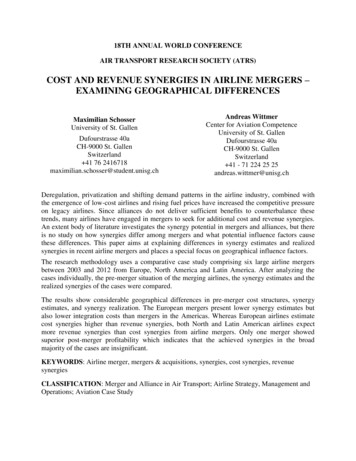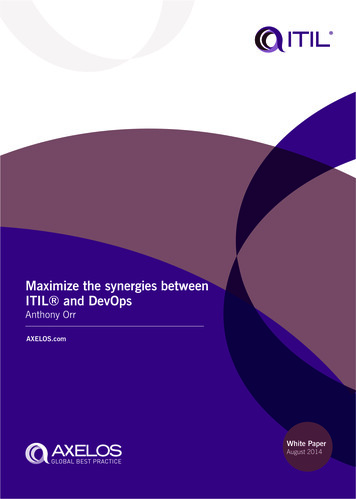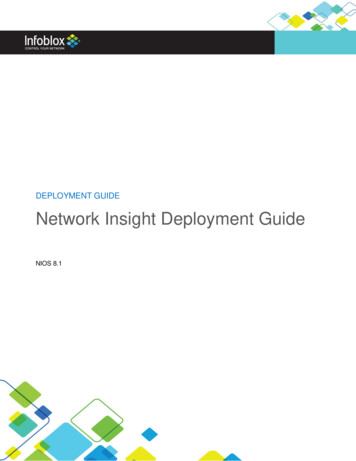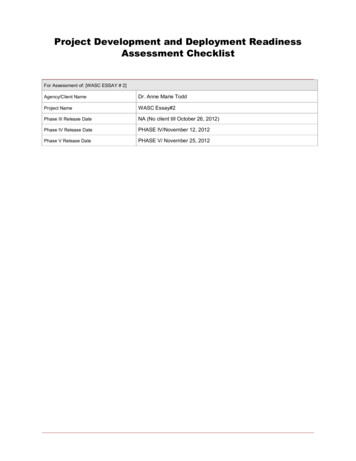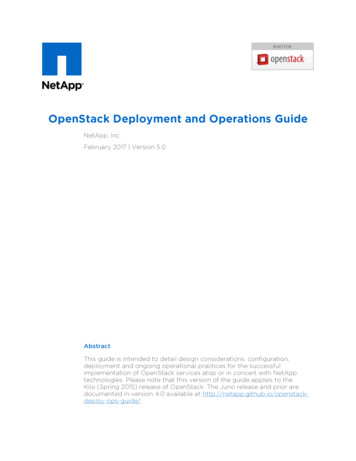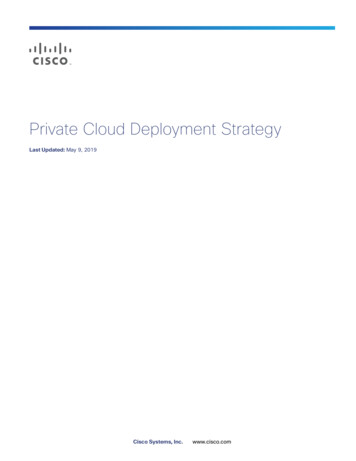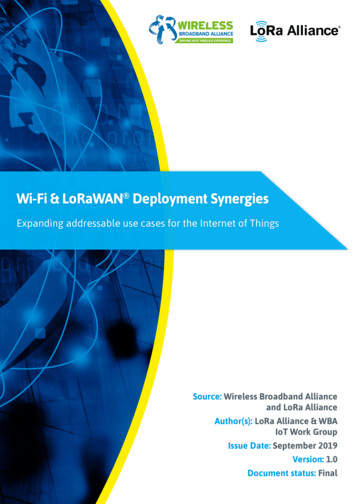
Transcription
Wi-Fi & LoRaWAN Deployment SynergiesExpanding addressable use cases for the Internet of ThingsSource: Wireless Broadband Allianceand LoRa AllianceAuthor(s): LoRa Alliance & WBAIoT Work GroupIssue Date: September 2019Version: 1.0Document status: Final
ABOUT THE WIRELESS BROADBAND ALLIANCEFounded in 2003, the vision of the Wireless Broadband Alliance (WBA) is to drive seamless,interoperable service experiences via Wi-Fi within the global wireless ecosystem. WBA’s mission is toenable collaboration between service providers, technology companies and organizations to achievethat vision. WBA undertakes programs and activities to address business and technical issues, as wellas opportunities, for member companies.WBA work areas include advocacy, industry guidelines, trials and certification. Its key programs includeNextGen Wi-Fi, 5G, IoT, Testing & Interoperability and Roaming, with member-led Work Groupsdedicated to resolving standards and technical issues to promote end-to-end services and acceleratebusiness opportunities. WBA’s membership is comprised of major operators and leading technologycompanies, including Broadcom, BSNL, Orange, Facebook, Google, HPE Aruba, Huawei, Microsoft,NTT DOCOMO Ruckus, Shaw, SK Telecom and T-Mobile US.The WBA Board includes AT&T, Boingo Wireless, BT, Cisco Systems, Comcast, Deutsche TelekomAG, GlobalReach Technology, Intel and KT Corporation. For a complete list of current WBA members,please click here.Follow Wireless Broadband Alliance om/company/wireless-broadband-allianceABOUT THE LORA ALLIANCEThe LoRa Alliance is an open, nonprofit association that has become one of the largest and fastestgrowing alliances in the technology sector since its inception in 2015. Its members closely collaborateand share expertise to develop and promote the LoRaWAN protocol, which is the de facto globalstandard for secure, carrier-grade IoT LPWAN connectivity. LoRaWAN has the technical flexibility toaddress a broad range of IoT applications, both static and mobile, and a robust LoRaWANCertification program to guarantee that devices perform as specified. The LoRaWAN protocol has beendeployed by more than 100 major mobile network operators globally, and connectivity is available inmore than 140 countries, with continual expansion.LoRa Alliance , LoRaWAN and LoRaWAN CertifiedCM are trademarks of the LoRa Alliance.Report Title: Wi-Fi & LoRaWAN deployment synergiesIssue Date: September 2019Version: 1.0. final versionLoRa Alliance & Wireless Broadband AllianceConfidential & Proprietary Copyright 2019
UNDERTAKINGS AND LIMITATION OF LIABILITYThis Document and all the information contained in this Document is provided on an ‘as is’ basis withoutwarranty of any kind, either expressed or implied, including, but not limited to, the implied warranties ofmerchantability, fitness for particular purpose, or non-infringement.In addition, the WBA and LoRa Alliance , (and all other organizations who may have contributed to thisdocument) makes no representations or warranties about the accuracy, completeness, or suitability forany purpose of the information. The information may contain technical inaccuracies or typographicalerrors. All liabilities of the WBA and LoRa Alliance , (and all other organizations who may havecontributed to this document) howsoever arising for any such inaccuracies, errors, incompleteness,suitability, merchantability, fitness and non-infringement are expressly excluded to the fullest extentpermitted by law. None of the contributors makes any representation or offer to license any of theirintellectual property rights to the other, or to any third party. Any recipient shall rely on nothing in thisinformation or communication.The WBA and LoRa Alliance also disclaims any responsibility for identifying the existence of or forevaluating the applicability of any claimed copyrights, patents, patent applications, or other intellectualproperty rights, and will take no position on the validity or scope of any such rights. The WBA and LoRaAlliance takes no position regarding the validity or scope of any intellectual property or other rights thatmight be claimed to pertain to the implementation or use of the technology described in this documentor the extent to which any license under such rights might or might not be available; nor does it representthat it has made any effort to identify any such rights.Neither the WBA or LoRa Alliance nor any of the other organizations who may have contributed to thisdocument will be liable for loss or damage arising out of or in connection with the use of this information.This is a comprehensive limitation of liability that applies to all damages of any kind, including (withoutlimitation) compensatory, direct, indirect or consequential damages, loss of data, income or profit, lossof or damage to property and claims of third-parties.Report Title: Wi-Fi & LoRaWAN deployment synergiesIssue Date: September 2019Version: 1.0. final versionLoRa Alliance & Wireless Broadband AllianceConfidential & Proprietary Copyright 2019
CONTENTS1Introduction and gap analysis . 12Wi-Fi technology . 53LoRa / LoRaWAN technology . 64Wi-Fi / LoRaWAN complementarity . 105Market overview . 116Market actors . 147Licensed / Unlicensed band strategy . 168Addressable use cases . 168.1Smart Building / Smart Hospitality . 178.2Smart City / smart Village . 208.3Smart Venue. 248.4Automotive and Smart Transportation . 268.5In Home / Consumer . 288.6Location services . 319Network Roll-out . 339.1Deployment models . 339.2Frontend integration. . 379.3Backend integration and security processes . 3710Interconnection processes . 4011Testimonials for actors deploying LoRaWAN and Wi-Fi . 4512Envisioning the future. 4913Summary. 52Report Title: Wi-Fi & LoRaWAN deployment synergiesIssue Date: September 2019Version: 1.0. final versionLoRa Alliance & Wireless Broadband AllianceConfidential & Proprietary Copyright 2019
1Introduction and gap analysisWi-Fi and LoRaWAN are two of the most adopted unlicensed technologies and together theyaddress a large proportion of IoT use cases. The approaches for these technologies are on thedisruption of private-public business models and also enabling participation in 5G success.The Wi-Fi & LoRaWAN Deployment Synergies white paper intends to demonstrate how these twowidely deployed IoT Connectivity technologies can be utilized in tandem to effectively support a vastarray of use cases. This paper will summarize the strengths of each technology, their individualpositions in the IoT ecosystem, state their complementary nature, the way that both technologies canbe easily deployed simultaneously and provide testimonials.The work aims to showcase to Wi-Fi network owners and/or network service providers how LoRaWAN can be deployed on the top of an existing Wi-Fi network and, as a complement, will allow foroperational costs optimization.The opposite is also relevant in raising Wi-Fi awareness through the LoRaWAN ecosystem. Theingredients of the recipe: network roll-out, targeted use cases, interconnection, and security aredescribed in this document.Due to the disperse requirements of all potential use cases, multiple IoT connectivity technologies havebeen developed in the IoT domain for the last 20 years, previously known as M2M. The Technologychoice is driven by factors such as cost efficiency, data rate, battery consumption, and rangerequirements.Below is a list of the most deployed IoT Connectivity technologies: Short Range: IEEE 802.15.4 (ZigBee, 6LoWPAN ), Bluetooth/BLE, Z-Wave, IEEE 802.11ad (WiGig). Medium Range: Wi-Fi, IEEE 802.11ah (Wi-Fi HaLo), IEEE 802.11p (vehicular transmissionsystems). Long Range LPWAN: LoRa / LoRaWAN , SigFox, Wi-Sun, Ingenu, DASH-7, Weightless. Long Range Cellular: 2G-GSM / GPRS / IS 95 (CDMA 2G), 3G UMTS / CDMA, Long TermEvolution, NB-IoT, LTE-M (Cat M1), CBRS, Multi-Fire, 5G.Report Title: Wi-Fi & LoRaWAN deployment synergiesIssue Date: September 2019Version: 1.0. final version1LoRa Alliance & Wireless Broadband AllianceConfidential & Proprietary Copyright 2019
Some IoT Connectivity technologies are based on cellular networks and use licensed spectrum (LTEM, NB-IoT, 2G, 3G, 4G, 5G) that can only be deployed by Mobile Network Operators (MNO’s). Recentadvancements in 3GPP (LTE LAA, and 5G NR Standalone) and Multi-Fire have made it possible fornon-MNOs to deploy cellular networks in the unlicensed spectrums, commonly known as Private LTEnetworks. Examples include the 2.6 GHz Time Division Duplex (TDD) band available in France for localPMR like services and the CBRS in the US. While there are certain advantages to Private LTENetworks, they commonly rely upon significant investments in infrastructure, support andadministration.Other IoT connectivity technologies operating in the unlicensed spectrum (Wi-Fi, LoRaWAN , Zigbee,Zwave, and Bluetooth) can be potentially deployed by any type of actor: MNO’s, Internet ServiceProviders (ISP), Multi-Service Operators (MSO), enterprises, cities, and/or developer communities.Some are predominant on the consumer market (mostly short-range technologies including Wi-Fi),others are more predominant on enterprise market (including LoRaWAN and Wi-Fi). As stated earlierthe primary focus of this paper is centered upon Wi-Fi and LoRaWAN .Recent IoT market developments and analysis prove that unlicensed and licensed spectrum bandtechnologies are not only complementary but that it is essential to leverage both. Two leadingunlicensed technologies in IoT are Wi-Fi and LoRaWAN . Wi-Fi is the unprecedented leader inbroadband connectivity and LoRaWAN is the leader in long-range, low power connectivity.With over 20 years of history and advancements, Wi-Fi has become the world’s most common radionetwork for consumers and IoT. For example, today most MNOs around the world rely upon Wi-Finetworks to offload data generated by devices (voice, internet) located in buildings or in dense urbanenvironments such as malls or venues. In 2018, Wi-Fi carried 67% of all mobile traffic in the US and83% in Japan [1]. Likewise, LoRaWAN has enjoyed similar rapid success. In just 3 years LoRaWAN has been adopted by more than 100 network operators, including leading MNOs such as Objenious,Orange, Proximus, KPN, NTT Docomo, SKT, KDDI, Swisscom [2] and Tata Communications, a digitalinfrastructure provider.As a reminder, the objective of this Wi-Fi & LoRaWAN Deployment Synergies white paper is NOTto make a comparison of all IoT Connectivity technologies. The purpose of the paper is to focus on: Demonstrating Wi-Fi’s complementary role with a globally adopted unlicensed technology:LoRaWAN , driven by similarities of go to market structures. The combination of theseunlicensed technologies allows covering the large majority and diversity of most IoT use cases,rolled out by any type of market actor.Looking at the market structure, Wi-Fi and LoRaWAN market proponents show great similarities. Allkinds of market actors exist and may interconnect with each other: MNOs, MSOs, Enterprises, Cities,Open Developer communities, etc. Organic growth from enterprise and private networks is currentlysupplementing targeted network growth from MNOs.As mentioned below (GSMA[3]), IoT covers typically two main categories of use cases which can applyto any IoT Connectivity technology:Report Title: Wi-Fi & LoRaWAN deployment synergiesIssue Date: September 2019Version: 1.0. final version2LoRa Alliance & Wireless Broadband AllianceConfidential & Proprietary Copyright 2019
Figure 1 - Type of IoT Use Cases Massive IoT, connecting billions of objects, transmitting a low amount of data, at a low data rate, mostlybattery powered, designed to optimize energy consumption and lasting up to 15 years once installed. Onecan find applications in many verticals such as: utilities, cities, agriculture, logistics, buildings (airports, hotels,stadiums, multi-dwelling units, home, venues ), and supply chain or transportation. Critical IoT, connecting millions of objects, communicating high amounts of data, at a higher data rate, withlow latency and high reliability, which mostly also results in higher power consumption. We find applicationsin transportation (connected vehicle, traffic control ), smart health (surgery, patient monitoring ), andindustry (real-time applications, robots, remote manufacturing).Figure 2 - Massive IoT versus Critical IoTReport Title: Wi-Fi & LoRaWAN deployment synergiesIssue Date: September 2019Version: 1.0. final version3LoRa Alliance & Wireless Broadband AllianceConfidential & Proprietary Copyright 2019
Today Wi-Fi is most often deployed to support critical IoT use cases whereas LoRaWAN is utilized formassive IoT use cases. When used in tandem, the two technologies support a vast array of IoT usecases in the following verticals: Smart building / smart Hospitality Smart cities / smart villages Smart venues Smart automotive and transportation In-home consumerTechnical options to deploy Wi-Fi and LoRaWAN in a mutualized infrastructure are covered in latersections with the purpose of highlighting that an existing Wi-Fi infrastructure can be easilyleveraged to deploy LoRaWAN as plug-in on Access Points (APs) or in Customer Premise Equipment.The level of integration (colocation or equipment convergence) will depend on coverage needs, sensordensity and business requirements like SLAs. Technical integration will be discussed from the frontend(equipment) and backend integration (cloud) viewpoints, also covering security and interconnectionprocesses. The lower cost and operation efficiency of a mutualized rollout compared to the deploymentof both Networks separately will become obvious.Testimonials in later sections from Wi-Fi providers deploying LoRaWAN will reinforce the messagethat Wi-Fi and LoRaWAN are widely implemented globally in real use cases supported by a strongecosystem, while also being strongly synergistic. Examples of these use cases include: Equipment suppliers working on mutualized software and hardware solutions (e.g.: Multi-Tech[38],Gemtek, Ufi, or Ruckus have combined Wi-Fi / LoRaWAN access points). IoT device makers offering embedded Wi-Fi & LoRaWAN combined solutions, such as multitechnology trackers like Abeeway, OFO, Maxtrack, Chipsafer, and Gemtek. Cities or public bodies moving to IoT: ER-Telecom in Russia deploying citywide Wi-Fi andLoRaWAN in top 60 cities [4] or city of Calgary who has complemented its Wi-Fi network with aLoRaWAN infrastructure. MNOs driving a harmonized licensed and unlicensed strategy such as Orange [5] and BT [6]. Unlicensed operators focusing on LoRaWAN IoT strategy like Unitymedia [7] in Germany, andTata Communications in India, Charter and Comcast in the US. Roaming / Interconnection leaders driving a harmonized strategy to interconnect multiple IoTConnectivity technologies such as Orange, Syniverse, or BSG.Lastly, we expect that simultaneous deployments of Wi-Fi and LoRaWAN to support IoT will have longterm benefits. Both technologies have a strong history of market success, long term roadmaps andhave a clear direction to support the future 5G world.Report Title: Wi-Fi & LoRaWAN deployment synergiesIssue Date: September 2019Version: 1.0. final version4LoRa Alliance & Wireless Broadband AllianceConfidential & Proprietary Copyright 2019
2Wi-Fi technologyWi-Fi is a family of radio technologies commonly used for wireless local area networking (WLAN) ofdevices. It is based on the IEEE 802.11 family of standards. Wi-Fi is a trademark of the Wi-Fi Alliance.Wi-Fi uses multiple parts of the IEEE 802 protocol family and is designed to seamlessly interwork withthe wired protocol Ethernet.Devices that can use Wi-Fi technologies include desktop and laptop computers, smartphones andtablets, smart TVs, printers, digital audio players, digital cameras, cars and drones, etc. Compatibledevices can connect to each other over Wi-Fi through a wireless Access Point as well as to connectedEthernet devices and may use it to access the Internet. Such an Access Point (or Hotspot) has a rangeof about 20 meters (66 feet) indoors and a greater range outdoors. Hotspot coverage can be as smallas a single room with walls that block radio waves, or as large as many square kilometers achieved byusing multiple overlapping access points.The different versions of Wi-Fi are specified by various IEEE 802.11 protocol standards, with thedifferent radio technologies determining the ranges, radio bands, and speeds that may be achieved.Wi-Fi most commonly uses the 2.4 GHz Ultra High Frequency (UHF) and the 5 GHz Super HighFrequency (SHF) SHF & Industrial, Scientific and Medical (ISM) radio bands; these bands aresubdivided into multiple channels. Each channel can be time-shared by multiple networks. Thesewavelengths work best for line-of-sight. Many common materials absorb or reflect them, which furtherrestricts range, but can tend to help minimize interference between different networks in crowdedenvironments. At close range, some versions of Wi-Fi, running on suitable hardware, can achievespeeds of over 1 GBps (Gigabit per second).IEEE 802.11Frequency bands used802.11a5 GHz802.11b2.4 GHz802.11g2.4 GHz802.11n2.4 & 5 GHz802.11acBelow 6 GHz802.11adUp to 60 GHz802.11afTV white space (below 1 GHz)700 MHz, 860MHz, 902MHz, etc.802.11ahISM bands depend on country802.11ax1 to 7 GHzFigure 3 - Wi-Fi StandardsReport Title: Wi-Fi & LoRaWAN deployment synergiesIssue Date: September 2019Version: 1.0. final version5LoRa Alliance & Wireless Broadband AllianceConfidential & Proprietary Copyright 2019
Wi-Fi 6 (11 ax) delivers improvements and new features that enable Wi-Fi devices to operate efficientlyeven in dynamic environments involving a large variety of device types. Below are the Wi-Fi 6 keycapabilities:Figure 4 - Wi-Fi 6 Key Capabilities (source: Wireless Broadband Alliance)3LoRa / Lo
Medium RangeWi -Fi , IEEE 802.11ah (Wi: Fi HaLo)IEEE 802.11p(vehicular transmission systems). Long Range LPWAN: LoRa
